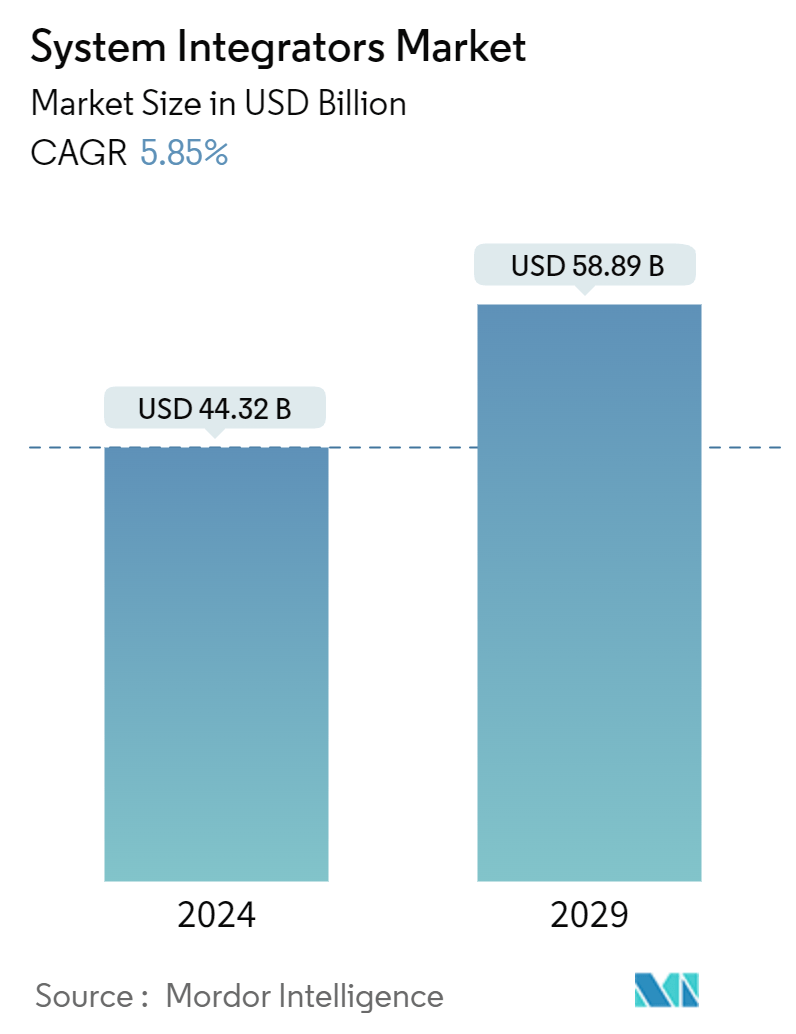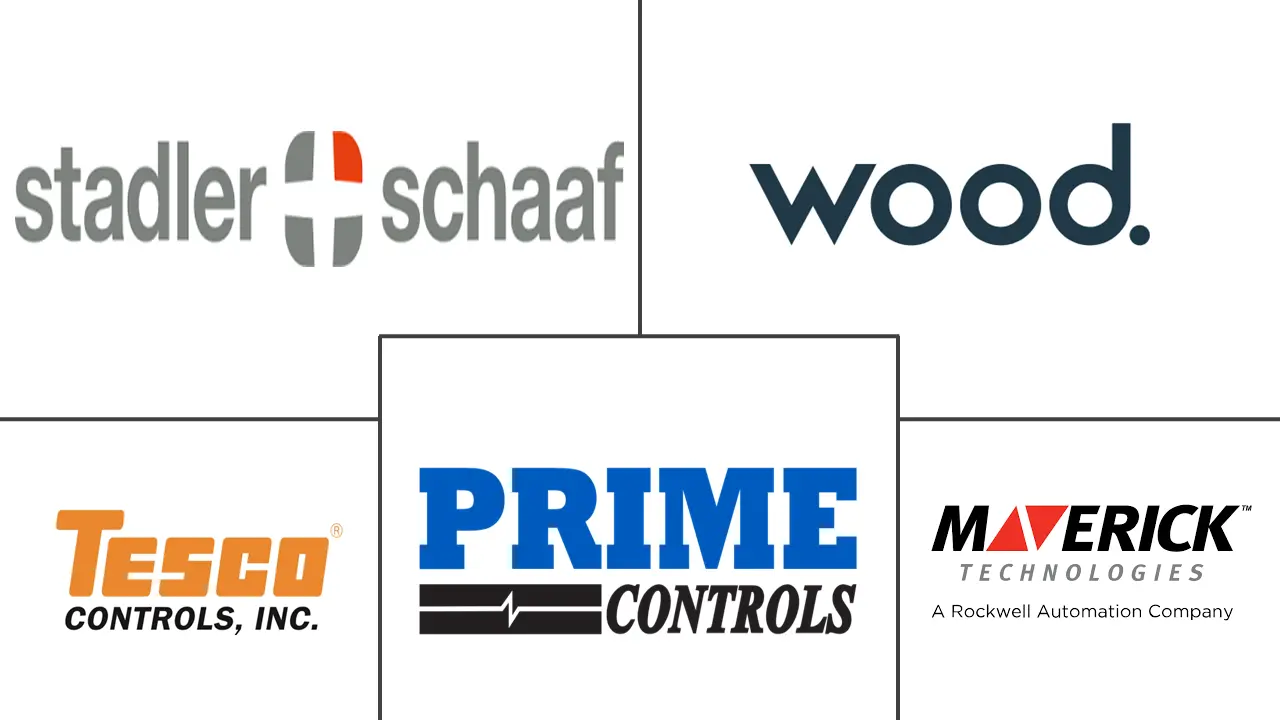Market Size of System Integrators Industry

| Study Period | 2019 - 2029 |
| Market Size (2024) | USD 44.32 Billion |
| Market Size (2029) | USD 58.89 Billion |
| CAGR (2024 - 2029) | 5.85 % |
| Fastest Growing Market | Asia Pacific |
| Largest Market | North America |
Major Players
*Disclaimer: Major Players sorted in no particular order |
System Integrators Market Analysis
The System Integrators Market size is estimated at USD 44.32 billion in 2024, and is expected to reach USD 58.89 billion by 2029, growing at a CAGR of 5.85% during the forecast period (2024-2029).
System Integrators specialize in conducting component subsystems together into a whole and ensuring that those subsystems function together. In today's era, manufacturing companies are introducing Flexible Manufacturing Systems (FMS) to break the classic trade-off between dependability and quality.
FMS reduces labor and process variability, improving the quality of the product, and consists of various production, material handling, and computer control modules. This further demands system integrators where the requirement of highly flexible control software makes it simple to integrate the machines with a system such as the PLC system and database.
- The demand for low-cost and energy-efficient production processes drives the market. The industry sector is one of the largest end-use sectors in terms of final energy demand and greenhouse gas emissions. System integrators have been involved in many traditional efficiency improvement activities like a motor replacement, inverters installation, etc., which are strictly related to energy usage reduction. But system integrators can also help a company reduce its environmental impact through operations optimization.
- Connecting the information coming from the production plant and then crossing them with energy consumption information and point-of-sale (POS) details can provide reports that can help identify possible optimizations, whereas having all the information separate could not have been enlightening. Further, one can expect low-cost development tools and the necessary training and support by participating in the system integrator program.
- Further, the growing use of IoT in industrial automation drives the market. The automation systems integrators are equipped with opportunity because, in most businesses, the usage of IoT solutions is shifted from being handled by the IT department to operations, and due to an existing relationship between operations and system integrators, it will, therefore, be easy for systems integrators to cooperate with IIoT vendors.
- Due to the increasing use of the Internet of Things in industrial automation, there will be a wide range of opportunities for market expansion. The vast majority of businesses as well as the already-existing relationship between system integrators and market operations offer automation systems integrators a plethora of opportunity. The market players' growing need for flexible manufacturing suppliers also increases the likelihood that the system integrator business will grow favorably over the next years.
- In the current business environment, which is technology-driven, Big Data stands as one of the primary drivers of manufacturers' productivity and efficiency. With the high rate of adoption of connected devices and sensors and the enabling of M2M communication, there has been a massive increase in the data points generated in the manufacturing industry.
System Integrators Industry Segmentation
System Integrators are the companies or individuals that implement, plan, coordinate, schedule, test, improve, and maintain a computing operation. System Integrators (SI) include companies that integrate systems such as Supervisory control and data acquisition (SCADA), Manufacturing Execution System (MES), and Human-Machine Interface (HMI), among others.
The system integrators market is segmented by service type (infrastructure integrators, software integrators), end-user industry (oil & gas, automotive, aerospace & defense, healthcare, power, chemical and petrochemical), and geography (North America, Europe, Asia Pacific, Rest of the World). The market sizes and forecasts are provided in terms of value (USD) for all the above segments.
| By End-user Industry | |
| Oil and Gas | |
| Automotive | |
| Aerospace and Defense | |
| Healthcare | |
| Energy & Power | |
| Chemical and Petrochemical | |
| Others |
| By Geography*** | |
| North America | |
| Europe | |
| Asia | |
| Australia and New Zealand | |
| Latin America | |
| Middle East and Africa |
System Integrators Market Size Summary
The system integrator market is poised for significant growth, driven by the increasing demand for flexible manufacturing systems and the integration of IoT solutions in industrial automation. System integrators play a crucial role in combining subsystems into cohesive units, ensuring seamless functionality. This demand is further fueled by the need for low-cost, energy-efficient production processes, as well as the growing emphasis on reducing environmental impact through operational optimization. The adoption of IIoT and automation technologies is enhancing connectivity and productivity in manufacturing, offering substantial opportunities for market expansion. The market is characterized by a fragmented landscape with numerous local, regional, and international players, all vying for competitiveness through partnerships, collaborations, and acquisitions.
North America is expected to maintain a significant share of the system integrator market, driven by technological advancements and the increasing prevalence of automation solutions. The region's focus on integrating robotic technologies and advanced industrial automation systems is bolstered by the availability of 5G wireless technology and the rising demand for augmented and virtual reality applications. Key players in the market, such as John Wood Group Plc and Tesco Controls Inc., are leveraging innovative strategies to meet the diverse demands across industries. The market's competitive nature is further intensified by strategic acquisitions and collaborations, which are essential for maintaining a competitive edge and expanding market reach.
System Integrators Market Size - Table of Contents
-
1. MARKET INSIGHTS
-
2. MARKET SEGMENTATION
-
2.1 By End-user Industry
-
2.1.1 Oil and Gas
-
2.1.2 Automotive
-
2.1.3 Aerospace and Defense
-
2.1.4 Healthcare
-
2.1.5 Energy & Power
-
2.1.6 Chemical and Petrochemical
-
2.1.7 Others
-
-
2.2 By Geography***
-
2.2.1 North America
-
2.2.2 Europe
-
2.2.3 Asia
-
2.2.4 Australia and New Zealand
-
2.2.5 Latin America
-
2.2.6 Middle East and Africa
-
-
System Integrators Market Size FAQs
How big is the System Integrators Market?
The System Integrators Market size is expected to reach USD 44.32 billion in 2024 and grow at a CAGR of 5.85% to reach USD 58.89 billion by 2029.
What is the current System Integrators Market size?
In 2024, the System Integrators Market size is expected to reach USD 44.32 billion.

